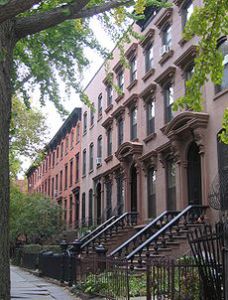 Prospect Heights is a neighborhood in the northwest of the New York City borough of Brooklyn. The traditional boundaries are Flatbush Avenue to the west, Atlantic Avenue to the north, Eastern Parkway to the south, and Washington Avenue to the east. In the northern section of Prospect Heights are the Vanderbilt Railyards, which could become part of the massive and controversial Atlantic Yards project.
Prospect Heights is a neighborhood in the northwest of the New York City borough of Brooklyn. The traditional boundaries are Flatbush Avenue to the west, Atlantic Avenue to the north, Eastern Parkway to the south, and Washington Avenue to the east. In the northern section of Prospect Heights are the Vanderbilt Railyards, which could become part of the massive and controversial Atlantic Yards project.
Compared to other Brooklyn neighborhoods, Prospect Heights is relatively small and is notable for its cultural diversity as well as its tree-lined streets. Prospect Heights has seen rapid demographic changes over the last decade, and its shifts are exemplified by a mixture of older buildings under reconstruction, rows of classic 1890s brownstones, and newly built luxury condominiums. The neighborhood is served by the New York Police Department’s 77th Precinct.
Along the southern boundary, Eastern Parkway, from Grand Army Plaza to Washington Avenue is reminiscent of Manhattan’s Fifth Avenue “Museum Mile”. Immense, opulent buildings line the north side of the parkway, and the south side features the Brooklyn Public Library, Mount Prospect Park (not to be confused with Prospect Park), the Brooklyn Botanic Garden and the recently renovated Brooklyn Museum. To its north lies Fort Greene, to the south, Prospect Park, to its west, Park Slope and to its east, Crown Heights.
The interior portion of the neighborhood consists mostly of brownstone-style residential rowhouse buildings, some built as early as 1890, although some blocks, such as Lincoln and St. Johns Place between Underhill and Washington Avenues, include larger multi-unit apartment buildings. A number of new condominium complexes are under construction in many parts of the neighborhood.
Defunct bakeries and factory spaces line Pacific Street from Vanderbilt Avenue to Carlton Avenue, and some have recently been renovated and converted into lofts; still others have recently been purchased by developer Bruce Ratner in anticipation of his Atlantic Yards Project. Recently, a number of these have begun to be demolished.
Ratner’s company Forest City Ratner has planned a controversial development on top of the neighborhood, the plans for which would include a basketball arena and luxury housing. An upscale, glass high-rise residential building designed by the architect Richard Meier and located off of Grand Army Plaza was completed in 2008.
As demand for housing within Prospect Heights increased, some residents of Crown Heights came to consider Franklin Avenue the western border with Prospect Heights rather than Washington Avenue. However, Washington Ave remains the eastern border of Prospect Heights as recognized by major New York City media such as The New York Times and The New York Post.
The name “Prospect Heights” can be traced as far back as 1889 to a letter to the editor published in the Brooklyn Eagle, although at that time it was one of several potential names for the neighborhood that has since come to be known as Park Slope. The letter began by noting that it was “amusing to see the attempts made to fix upon a name for the rapidly growing part of Brooklyn near Prospect Park, bounded by Flatbush, Fifth and Ninth avenues, Some call it Park Slope, some Park Hill Side, some Prospect Heights and others Prospect Hill.
